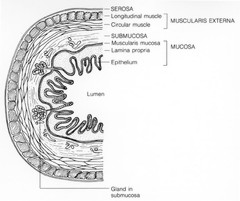| Description: |
Line drawing showing the lining of the GI tract: colorectal (muscularis). The walls of the digestive tract have four layers of tissue: mucosa, submucosa, muscularis externa and serosa. The inner-most layer is the mucosa, a membrane that forms a continuous lining of the GI tract from the mouth to the anus. In the large bowel, this tissue contains cells that produce mucus to lubricate and protect the smooth inner surface of the bowel wall. Connective tissue and muscle separate the muscosa from the second layer, the submucosa, which contains blood vessels, lymph vessels, nerves and mucus-producing glands. Next to the submucosa is the muscularis externa, consisting of two layers of muscle fibers-one that runs lengthwise and one that encircles the bowel. The fourth layer, the serosa, is a thin membrane that produces fluid to lubricate the outer surface of the bowel so that it can slide against adjacent organs.
|
